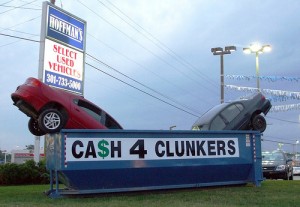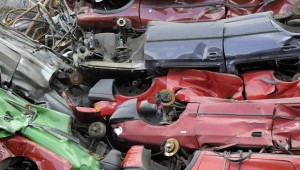I’m keeping my clunker. And you should, too.
 Mine’s a Honda Accord, so it doesn’t actually qualify as a clunker despite its 150,000 loyal miles, but on principle I would not do “cash for clunkers.” Let me tell you why.
Mine’s a Honda Accord, so it doesn’t actually qualify as a clunker despite its 150,000 loyal miles, but on principle I would not do “cash for clunkers.” Let me tell you why.
Long before the word warming was ever married to global, we understood we were filling landfills too quickly. The concept of recycling emerged, and attentive citizens learned the mantra reduce, reuse and recycle. In that order.
Thus my first beef with cash for clunkers: It puts the recycle cart before the reduce and reuse horses, and in this case recycle is a euphemism. Although cash for clunkers sounds kind of green, it equates to destroy and produce.
You annihilate a working automobile by pouring sodium silicate (liquid glass) into the engine to ensure it never goes another mile, killing 30 percent of its resale value. A recycler removes some parts for resale, drains the haz-waste fluids, mashes it into a steel pancake, puts them on a barge to who knows where, or chops them into bits, producing carbon at every step.
Meanwhile, you produce a new car from materials mined from the good green earth, processed in a steel plant, shipped to an auto plant, manufactured with carbon-generating energy, shipped to dealerships and driven home by someone who just threw away the car that got him to the showroom. It takes somewhere between 3 and 12 tons of carbon dioxide to make a new car.
 (Since this is a clean tech blog, I won’t go off on the confiscatory aspect of this – why should you as a taxpayer pay for my new car? And if that’s what it takes to stimulate the economy, maybe we should just ride out the recession. I won’t harp on the fact that this is ultimately another staggering gift from your grandkids to the auto industry. Or that it feeds into our worst consumerist compulsions. Or worse, how four of the top five new car models that clunkheads are buying are made by foreign automakers.)
(Since this is a clean tech blog, I won’t go off on the confiscatory aspect of this – why should you as a taxpayer pay for my new car? And if that’s what it takes to stimulate the economy, maybe we should just ride out the recession. I won’t harp on the fact that this is ultimately another staggering gift from your grandkids to the auto industry. Or that it feeds into our worst consumerist compulsions. Or worse, how four of the top five new car models that clunkheads are buying are made by foreign automakers.)
I’ll stick to our focus and observe that cash for clunkers is about as green as bottled water. The policy goes out of its way to stimulate the unnecessary manufacture, distribution and consumption of objects that are ultimately superfluous. In the best case, you’re taking a pig off the road and replacing it with a hybrid, the net gas-mileage/pollution benefit offset by the impacts of manufacturing the hybrid and destroying the clunker. Oh, and not every beneficiary of the program is buying a Prius. Did you know that a new car that gets 22 mpg qualifies for a cash for clunkers subsidy? That’s a pretty low bar.
The crime in all this is that what Washington and we in the middle class call a clunker is quite often a perfectly serviceable means for a lower-income or unemployed person to get to work, see the doctor or take in a ballgame. A clunker can carry meals to seniors or homeless people to shelters. It can give the kids at the tech school some fodder for learning a valuable trade while transforming a clunker into a cream puff.
Cash for clunkers: It’s your cash. Clunkerhood is in the eye of the beholder. It’s not making us green, and it’s putting us in the red. Don’t do it.
– – –
Got an opinion? Tell us what you think.